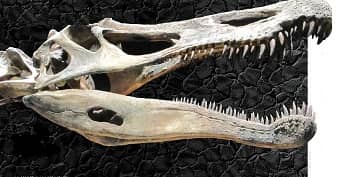
Often quite different from their more familiar North American counterparts and adorned with bizarre frills, bumps, dorsal sails, and crests, these new southern “terrible lizards” are changing many of our perceptions about dinosaurs. As an example, consider the now-diminished status of the iconic Tyrannosaurus rex, the fiercest North American predator. The most widely recognized of all dinosaurs, T. rex had long been considered the biggest, baddest carnivore ever to walk the Earth. But now it seems that T. rex, whose name loosely means “king of the tyrant lizards,” is not really the king after all. It has recently been surpassed in both size and probable ferocity by Giganotosaurus from South America and Spinosaurus from Africa. This discussion about southern dinosaurs was inspired by my opportunity to view the spectacular traveling exhibition, Ultimate Dinosaurs. In the presentation, seventeen of these strange southern dinosaurs are displayed. The collection was created and produced by the Royal Ontario Museum, Toronto, Canada, and presented by the Science Museum of Minnesota. The exhibition explains the southern dinosaurs as products of continental drift and subsequent evolutionary isolation through spectacular skeletal mounts and outstanding interpretive displays.
DYNAMIC DINOSAUR DISCOVERIES
This story is from the December 2020 edition of Rock&Gem Magazine.
Start your 7-day Magzter GOLD free trial to access thousands of curated premium stories, and 9,000+ magazines and newspapers.
Already a subscriber ? Sign In
This story is from the December 2020 edition of Rock&Gem Magazine.
Start your 7-day Magzter GOLD free trial to access thousands of curated premium stories, and 9,000+ magazines and newspapers.
Already a subscriber? Sign In

This News is for the Birds
The amazing range of the would-be birds!
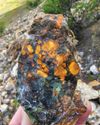
CALIFORNIA MAGNESITE PLASMA AGATE
California magnesite plasma agate is a kaleidoscope of minerals. Much like its neighbor from Clear Creek, it contains chalcedony, serpentine, jadeite and chromite.
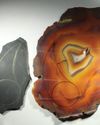
HOW TO CREATE A CABBING MATERIAL
Even though Mother Nature creates almost unbounded types and numbers of beautiful materials for cabbing, often I struggle to find a slab that will work for the project that I want to do.
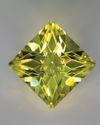
PINWHEEL - VIET GEMS 149
I am frequently asked what my favorite gemstone designs are and where to find them. After my trip to the Tucson Gem and Mineral Show, I updated my list of favorites to include gemstone designer, Phan Thanh Trung.
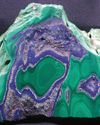
Copper Minerals: My Favorite
I have lived in the “Copper State” of Arizona for 65 years so it should not surprise readers that copper minerals are among my favorites to collect.
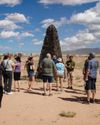
OPPENHEIMER, TRINITY SITE AND TRINITITE
The widely acclaimed, 2023 Hollywood biographical movie Oppenheimer recently won seven Academy Awards including Best Picture and Best Actor (Cillian Murphy).

Clearing ,Smudging & Setting Intentions for Stones
Why do you believe what you believe? Are your beliefs true because you choose to believe them? Whether it is religion, science or the metaphysical, your belief and faith make it real to you in mind, body and soul.

Rhode Island's Hobbit Stone Age
Rhode Island may be 22nd out of 30 states in miles of total coastline but when you compare coastline length to land acres, it ranks second only to Maryland.
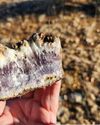
Black Range Amethyst
Amethyst in Southwest New Mexico

EQUINE Bling!
How an Oklahoma Saddle Maker Uses Moissanite, Gold, Silver Turquoise tc to Adorn Saddles Jewelry